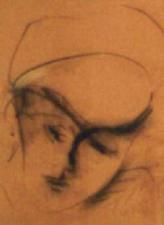E.J. Gold
Biography
E.J. Gold is a master artist. His proficiency extends into many artistic media, including painting and sculpting as well as professional video and music recording, computer game writing, and virtual reality wizardry. Gold has created a diversified and monumental oeuvre in the course of the forty years of his career as an artist. All his work speaks of breathtaking vision, technical expertise, uncompromising discipline, and engaging humor.
E.J. Gold was born in New York City in 1941. As the son of H.L. Gold, the editor of Galaxy Science Fiction magazine, he grew up surrounded by artists and intellectuals, the Who’s Who in the Arts in America of the 40's and 50's: Isaac Asimov, Arthur C. Clarke, Robert Heinlein, Charles Laughton, Orson Welles, John Cage, Merce Cunningham, Pete Seeger...
The New York School, Otis Art Institute in Los Angeles, Rico Lebrun and Fritz Schwaderer are among his early influences. A member of the infamous California Nine, a guerilla artist group of the sixties, he was widely recognized for his invention of soft and breathing sculptures.
Gold is a perceptual scientist who uses art as his primary investigative tool. He is the principal author of the Manifesto on Reductionism published jointly with the Grass Valley Graphics Group, an artistic enclave at the cutting edge of experimentation in objective art where visual elaboration is reduced to a minimum. In keeping with the tenets of reductionism, instead of drawing on personal elements of past experience, the artist directs his attention to the world of stillness and silence that lies just on the other side of the veil.
Gold’s work often violates scale, at once denying dimension and perspective. By making use of color, form, texture, negative space, forced perspective, compressions, color field and figure-ground relationships, Gold depicts the world beyond the boundaries of space and time, portraying timeless eternity.
Some of Gold’s more well-known series of paintings include the Faces of War, PlanarContiguities, Odalisques, Guides, Moonbeam, White House Series, Expressionist Landscapes, Sanitarium Series, Angels, Monumentals, Haunted Corridors, and City in the Sky.
These powerful paintings by this remarkable shamanic artist are gateways to sublime mystical experiences. They are profoundly experiential and impenetrable by the mind but have the ability to awaken higher centers. Therein lies their key.
SCHOOL OF REDUCTIONISM
Conceived in 1987 by E.J. Gold, a prominent American artist, and other members of the Grass Valley Graphics Group, an artist's community in northern California. The School consists of more than 20 American and Canadian painters and sculptors who have worked with Gold to reformulate the aims and principles of contemporary visual art.
Reductionism embodies both a philosophy of art and certain practical principles which infuse its works with recognizable qualities.
The philosophy of Reductionism places utmost value on the creative act which originates as an aesthetic perception and a corresponding state or condition of being. It is then the artist's task to capture or express this perception in a work of art which enables the viewer to have the same experience. Reductionist art is therefore objective in nature and not an exploration of the subjective states of the artist.
Artists of the School include: E.J. Gold, Della Heywood, Kelly Rivera, Heather Valencia, Stephanie Boyd, Menlo Macfarlane, Robbert Trice, Tom X., Claude Needham, Zoe Alowan, Richard Hart, Mark Einert, Douglass-Truth, Yanesh, Lidy Nova, Joe Alowan, Tim Elston, David Christie and more.
Although Reductionism in practice is broadly inclusive, experimental and evolving, its art is nonetheless often characterized by three basic qualities:
Essentialism
Reductionism uses recognizable objects and is therefore representational. However, objects are important for their effect, not important in themselves. The artist attempts to achieve an effect with the fewest possible lines and details, removing extraneous elements which may deviate or obscure the effect...thus the name Reductionism. Objects are reduced to their essentials in a move toward the abstract. Similarly, colour is used unambiguously and powerfully to enhance its effect. Colours are few, vibrant, sharply contrasting.
Timelessness
Reductionism typically explores another dimension of time, a dimension which is not sequential or "horizontal" but eternal or "vertical"...the same dimension of time which contains the creative act itself. There is little or no explicit movement in Reductionist art. Nothing is happening in the usual sense and time, therefore, does not pass. The result is an enhanced awareness of posture, positioning of visual elements and their inter-relationships. Freezing the frame, rendering objects static, also has the effect of freeing other forms of movement such as feeling...motion through emotion.
Space
Perhaps the outstanding feature of Reductionist art is that, despite a limited use of the techniques of perspective to create three dimensional effects within the picture, the art nonetheless establishes a sense of space. The reason is the primary place assigned to the viewer. Because the Reductionist artist strives for communication, scenes are composed for a viewer who is not a voyeur outside the scene but rather a participant who is the reason for the work and necessarily a part of it. Everything in the scene is oriented first and foremost to the viewer so as to bring the viewer into a relationship with it. Depth of field is therefore not bounded by the frame but includes the viewer in a truly three dimensional experience of space. Thus, the art is only completed by viewing.
 Charcoal on Sennelier">
Charcoal on Sennelier">
















